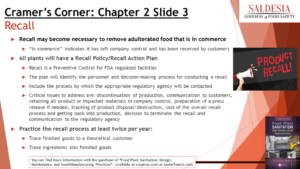Recall


RECALL; the mere mention of the word often causes nerves to twitch, sweat to bead on the brow and breathing to become rapid and shallow. No one wants to conduct a recall; it may mean consumer illness or injury, it will cause inconvenience for our customers, there will be financial impact to the company and there may be damage to reputation and brand equity. When it’s necessary to have product removed from commerce, it’s vital to have a Recall Policy and Action that identifies the personnel involved, the steps to be taken and the actions during and after a recall. It’s also valuable to practice implementation of the plan so that all involved are clear on their roles and responsibilities along with looking for areas to make it more effective and efficient.
In Chapter 2 of the book Food Plant Sanitation, entitled “Regulatory Inspection and Control Action”, Recall is reviewed in detail to aid in preparation of an effective and efficient process to help the company recover quickly.”
Slide Content
Recall may become necessary to remove adulterated food that is in commerce
– “In commerce” indicates it has left company control and has been received by customers
All plants will have a Recall Policy/Recall Action Plan
– Recall is a Preventive Control for FDA regulated facilities
– The plan will identify the personnel and decision-making process for conducting a recall
– Include the process by which the appropriate regulatory agency will be contacted
– Critical issues to address are: discontinuation of production, communication to customers, retaining all product or impacted materials in company control, preparation of a press release if needed, tracking of product disposal/destruction, cost of the overall recall process and getting back into production, decision to terminate the recall and communication to the regulatory agency
Practice the recall process at least twice per year:
– Trace finished goods to a theoretical customer
– Trace ingredients into finished goods
